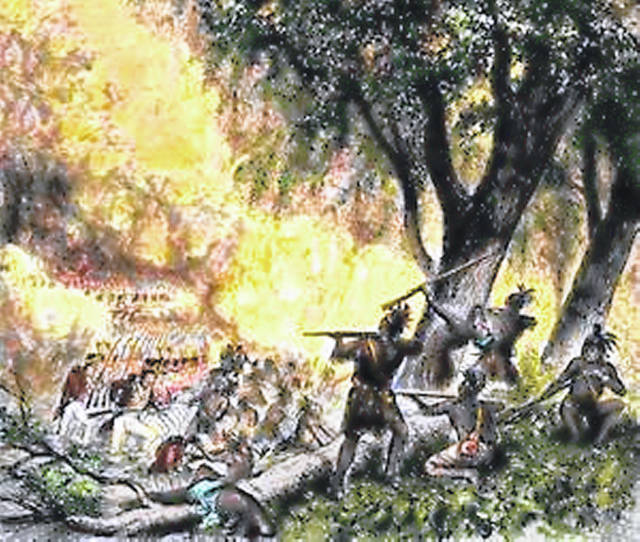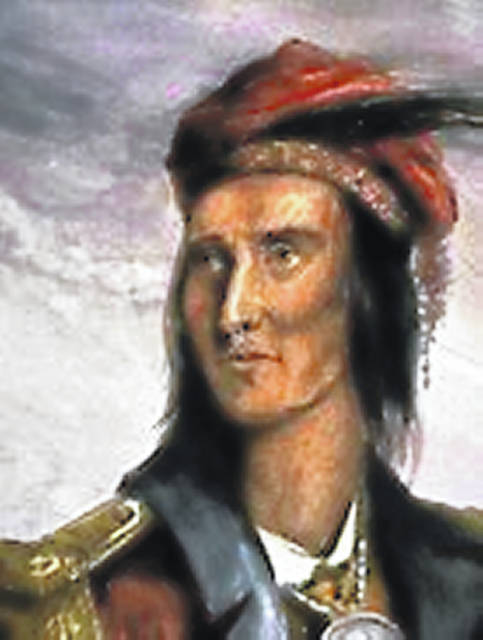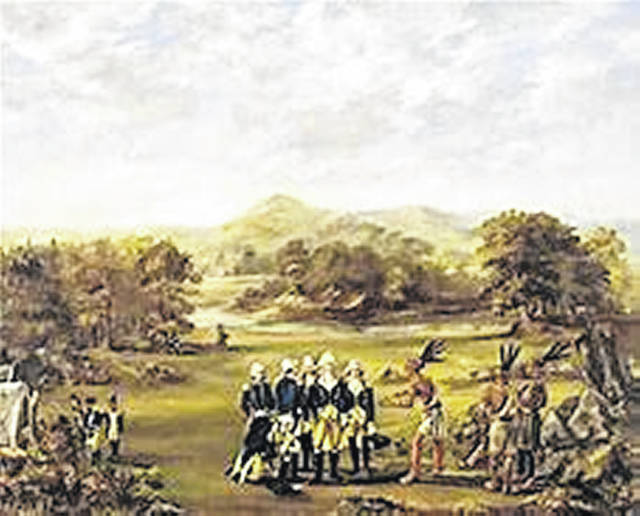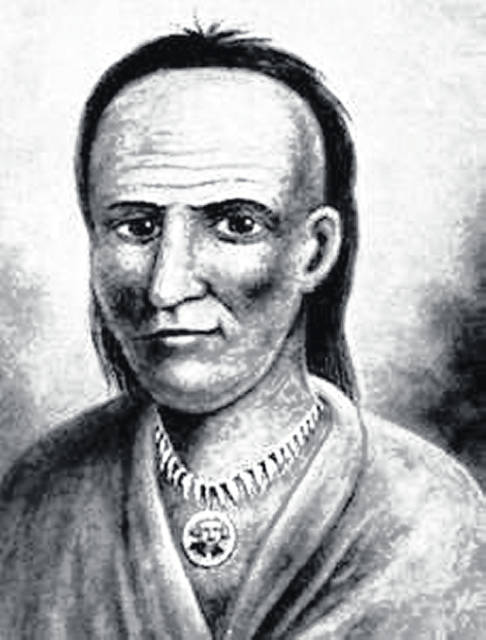




Editor’s note: in conjunction with the 200th celebration of the establishment of Shelby County, the Sidney Daily News will be publishing a year long series about the county’s history.
SIDNEY — Unfortunately, no written records exist concerning the first human occupation of what is now Shelby County. These early Indians may not have left behind notes and records, but traces of their existence nonetheless leave archaeologists able to tell us something about them.
The earliest inhabitants crossed over from what is now Siberia to North America about 13,000 years ago. The climate was much different then. A land bridge connected Siberia and this continent. The last major ice age had just ended. A large amount of the ocean’s water volume was in the form of ice, thus lowering the water lever which in turn created and Siberia-Alaskan connection.
The last glacier substantially changed the landscape. The Teays River, in size the long ago equivalent of the Ohio River today, had flowed south to north through Shelby County. It was filled in by the carving and sculpting of the last great ice sheet as it retreated. This glacier, over a mile thick in spots, also left behind glacial erratics, or boulders which were the bane of early farmers and are still common in our fields today.
The earliest inhabitants of what is now Shelby County encountered a landscape which was in the process of being cut and eroded again. The beginnings of the Great Miami River, Loramie Creek and other minor tributaries were starting to emerge.
West-Central Ohio’s original settlers were groups of what became known as the Paleo-Indians. They first arrived in the Ohio area around 13,000 B.C. Their principle source of food was the great mastodon, which migrated into this region after the ice retreated.
No skeletal remains from the Paleo-Indian people have been found, so their physical characteristics remain a mystery. Many of their tools (rocks shaped and sharpened to stab, slice, scrape or stun) and other artifacts have been discovered throughout Shelby County.
As early as 8,000 B.C., the Paleo Indian civilization progressed into what is now known as the Archaic Period. This period brought cultural and lifestyle changes for the natives. The Archaic Indians survived in this pre-agricultural era by hunting antelope and smaller game such as rabbit, wild turkey and quail. Fish were also a part of their diet along with wild vegetables and grains.
The Archaic Indians began to produce spear points, axes and knives from copper around 5,000 B.C. They buried their dead in huge gravel deposits left by the glaciers. When the pioneers moved into West-Central Ohio, they began to replace early mud roads with gravel mined from some of these deposits, and many skeletons were uncovered. Human bones have been found throughout Shelby County. Analysis of these remains has revealed that the males averaged 5 feet, 4 inches in height, and the women 5 feet. Their spoken language was never documented and will probably remain unknown.
The Hopewells succeeded the Archaic Indians. They developed a more sophisticated community structure. With centralized forms of community government, they could bring together large numbers of people to work on important construction projects, such as major mounds and fortifications.
The Adena Indians were the next group to thrive in Ohio. Adenas date from about 1,000 A.D. They were also known as the mound builders. The Adena built no mounds in Shelby County- although their artifacts have been found here.
Many sites in Ohio have produced treasured artifacts. In Shelby County these finds include points (arrowheads and spearheads) made from flint and chert, tools, pestles which were used to grind grains, and jewelry. The full grooved axes have been found which range from three inches to those weighing several pounds.
By the 1600s, the ancient inhabitants were gone. What is known as the Woodland Period began. Indians traveled through then inhabited this area. Chief among them were the Miami and Shawnee Indians. Both groups traveled in what is now Shelby County with the Shawnee claiming the east side of the Great Miami River and the Miami the west.
The Miami were more peace-loving. They moved from the Wisconsin area. In 1730, the first English traders are known to have been trading gunpowder, hatchets, rum, blankets, and beads with the Miami for valuable furs. Their principal chief was Little Turtle. Their main village in Ohio was Pickawillany – near present Piqua – but their strongholds were dotted throughout the Maumee and Miami River valleys. Villages there were destroyed in the 1790–1794 campaigns of generals Josiah Harmar and Anthony Wayne.
The Shawnee migrated here from what is now Florida. They were known as a fierce, war-like people. An important Shawnee village was located where present day Wapakoneta is today. It was the home of the great chief Black Hoof. His death was recorded in the first Sidney newspaper after his passing in 1834 at the age of 116.
Black Hoof visited President Thomas Jefferson early in 1802. He made the following comments:
“We live in a bad place for farming, the water is very bad in the summers; if you turn your head back you will hear the lamentations of our women and children, distressed for want of clothing and by hunger. It is our desire to live like good neighbors, as long as the grass grows and the water runs in the rivers.”
“The second request we make is that you will stop your people from killing our game. At present they kill more than we do. They would be very angry if we were to kill a cow or a hog of theirs, the little game that remains is very dear to us.”
Tecumseh was a Shawnee leader who has been ranked with the greatest chiefs and hero-figures of American Indian history. He was famous for his courage and intelligence. With his skills as an orator and leader, he labored to unite American Indian tribes into a strong confederation to resist the advance of white settlements.
In 1811, Tecumseh warned of the fate the American Indians would suffer unless they united to resist the white man. Here is part of his compelling speech to the Choctaw and Chickasaws tribes:
“What need is there to speak of the past? It speaks for itself and asks,
‘Where is the Pequod? Where the Narragansetts, the Mohawks…
and many other once powerful tribes of our race?’” They have vanished
before the avarice and oppression of the white men, as snow before a summer
sun. Look abroad over their once beautiful country, and what see you now?
Naught but the ravages of the pale face destroyers meet our eyes. So it will be
with you Choctaws and Chickasaws! Soon their broad roads will pass over
the graves of your fathers, and the place of their rest will be blotted out
forever. The annihilation of our race is at hand unless we unite in one common
cause…
With the signing of the Treaty of Paris in 1783, England lost the American Revolution and gave up its claims to land from the Atlantic Ocean to the Mississippi River. By this time, pioneer settlers had reached the eastern bank of the Ohio River, but the Ohio County, located west and north of the river was still considered Indian Territory. The Indian tribes desperately defended their hold on the land.
On Aug. 20, 1794, the United States forces led by Major General Anthony Wayne defeated an Indian alliance at the Battle of Fallen Timbers fought near modern-day Toledo. After this defeat, members of the western tribes assembled at Fort Greene Ville and signed the Greenville Treaty on Aug. 3, 1795. The United States offered payment and annuities in the form of goods and gave up claim to most land north and west of the treaty line. The line runs through Shelby County. This treaty marked the end of the Indian Wars in the Ohio Country. It opened much of Ohio for settlement.
Bibliography:
David lodge’s excellent writing on Indians for the Shelby County Historical Society beginning in 1997
Historic Indian tribes of Ohio materials from the Ohio Historical Connection
Ohio Secretary of State web site materials






